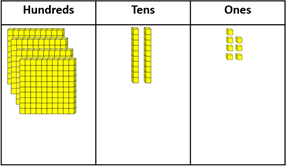Purpose
The purpose of this activity is to support students in understanding that tens are nested in hundreds, and ones are nested in both tens and hundreds. They also develop fluency in renaming three-digit numbers in multiple ways.
Achievement Objectives
NA2-4: Know how many ones, tens, and hundreds are in whole numbers to at least 1000.
Required Resource Materials
- Place value materials: individual items grouped into tens, such as BeaNZ in film canisters, ice block sticks bundled with rubber bands (hundreds with hair ties), or a paper form such as Place Value People. Bundled materials are important as they allow partitioning and combining without the need for “trading” tens blocks for ones.
- Calculators
- Use a place value board to organise the materials in columns and support calculation strategies. A three-column place value board is available here.
Activity
- Write a three-digit number on the board (or display it digitally) and tell students to make it with blocks or other place value materials on a place value board. You might need to demonstrate initially. If appropriate to your students' knowledge, you might include te reo Māori kupu for numbers throughout this activity. Note that in te reo Māori, the structure of the names of numbers is different to that in English (e.g. three hundred is toru rau - three hundreds). Consider whether this additional information will help or hinder your students.
For example, make the number 427.
- Discuss the number made.
How many ones are in 427? This may seem an obvious question, but students may not recall that a unit of one hundred is comprised of 100 ones.
How many tens are in 427? Students are most likely to say “two” since 2 occupies the tens place.
Where are the tens? Are there tens in each hundred? How many? How many tens are in 400? How many tens are in all of 427?
Use the place value materials to decompose the hundreds into tens, as necessary. Agree that there are 42 tens, and 7 ones in 427.
- Look for students to anticipate how many tens and ones are in a three-digit number, based on the place of the digits in each number and the knowledge that ten tens make 100 and ten ones make ten.
Discuss anticipation strategies. For example:
Can you know how many hundreds are in a three-digit number, like 849?
Can you work out how many tens are in a three-digit number, like 849?
Can you know how many ones are in a three-digit number, like 849?
Students may suggest an algorithm that the hundreds and tens digits tell how many tens can be made, e.g., 849 has 84 tens.
Provide time for students to practise using these strategies in small groups or pairs.
- Reverse the process by giving students tens and ones, using place value materials, and asking them to name the three-digit number. For example, make 15 tens, and 6 ones. 15 tens and 6 ones can be renamed as 1 hundred, 5 tens, and 6 ones (156).
Provide time for students to practise using these startegies in small groups or pairs.
- Good further examples include:
- 29 tens and 4 ones
- 40 tens and 9 ones
- 36 tens and 15 ones
- 41 tens and 23 ones
- Ask students to generalise and create place value block models of specified numbers:
- Make 519 with place value blocks. What is the easiest way to do that?
How many hundreds will you need? How many tens will you need? How many ones will you need? - Make 30 tens with place value blocks.
What number have you made? - Get 6 hundreds, 17 tens, and 12 ones.
What number have you made? - Get 23 tens, and 23 ones with place value blocks.
What number have you made?
- Make 519 with place value blocks. What is the easiest way to do that?
Next steps
- Push the concept of nested place value into the thousands. For example, get 14 hundreds. What number have you made?
Look for students to recognise that ten hundreds can be renamed as one thousand. Therefore, 14 hundreds can be represented as 1 thousand and 4 hundreds (1400). - Extend this generalisation to the number of tens in four-digit numbers, like 1567 (156 tens) or 1048 (104 tens).
- Provide open problems that invite students to find different ways to compose a given three-digit number. For example, 381 can be made as 3 hundreds, 8 tens and 1 one, or 2 hundreds, 18 tens and 1 one, or 3 hundreds, 7 tens, and 11 ones, etc.
Add to plan
Level Two